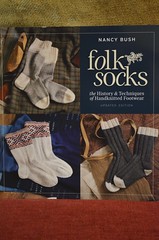First, the facts:
Title: Folk Socks: The History & Techniques of Handknitted Footwear (Updated Edition)
Author: Nancy Bush
Published by: Interweave Press, 2011
Pages: 151
Type: Sock history, techniques, and patterns
Chapters:
1. From Hide to Hose: The Origins of the Sock
2. Looped Fabrics & the Legwear of Queens: The Beginnings of Knitted Hose
3. Knitting in Great Britain: A Way of Working & A Way of Life
4. Knitting in Other European Countries: Traditions & Stocking Styles
5. Carrying on the Tradition: How to Knit a Sock
6. A Classic Sock Pattern: And Some Variations on Heel & Toe
7. The Patterns
The In-Depth Look:
This is practically THE classic sock book. First published in 1994, it explored so many areas of sock knitting that hadn’t been touched on before. The history, first of all, but also heel variations, and different ways to finish off a toe–all sorts of details. It was an eye-opener for knitters who had basically knitted the same heel-flap/gusset heel and grafted the same toe for their entire sock-knitting careers. Which is assuming that they’d knitted socks at all because, when I started knitting in 1988, there were practically no sock patterns out there–which is why it was the 21st century before I knit my first sock.
Nancy Bush’s “Folk Socks” was a revelation. Not only did she explore the (mostly European) history of the stocking and all its regional variations, she provided some truly beautiful traditional sock patterns. Like many books of the period, though, the original had something of a no-nonsense feel to it. There were pictures, but, well, compared to the stylish knitting books in vogue today, it doesn’t look like anything special–very plain vanilla and utilitarian.
So, when I tell you that book has been updated, does it make your heart beat a little faster?
Because the new version–a good 30-pages longer than the original–is a sight for spoiled eyes. It’s the same amazing book but now it’s also a beautiful little book with a more generous layout. It’s got larger pictures, more color, and generally more pizazz than my 1994 edition, which makes it a pleasure to flip through. The old edition felt a little more like a textbook. This one feels like eye candy.
The burning question, though, is … how are they different?
From the press release:
“This revised edition of Folk Socks contains the in-depth history and the step-by-step instruction from Nancy Bush that sock knitters have come to love and depend on, but is now completely updated. Discontinued yarns have been replaced with current yarns, and modifications that Nancy has learned since the book was first published have been added. Also new is a bonus section on Estonian-inspired socks.”
Without comparing my two copies word for word, I can say that they look pretty identical. The sections of history, the lists of patterns, all seem to be the same, with the one exception that the old “Greek Sock” pattern is completely replaced by the new “Estonian Crossroads” pattern and there are a couple modifications to some of the other ones. I can’t say for sure what the “modifications Nancy has learned since” are, though.
Do you need to buy the new update if you have the older edition? Probably not … but the new edition sure looks nice. I find it easier to browse through. Knitting books have evolved a lot in the last couple of decades, after all, and this is one book that deserved a nice face lift.
You can check it out here at Amazon.com.
Want to see bigger pictures? Click here.

This review copy was kindly donated by Interweave Press. Thank you!
Other posts for this author:



Comments on this entry are closed.
One thing is missing from the updated edition: the little photographs of the original socks that inspired the patterns. Now you only get to see her version, not the original.